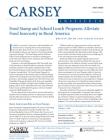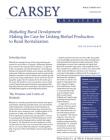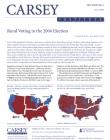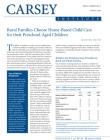Publications

July 1, 2007
The Food Stamp and the National School Lunch Programs play a vital role in helping poor, rural Americans obtain a more nutritious diet and alleviate food insecurity and hunger. This fact sheet looks at the extent to which rural America depends on these programs and describes characteristics of beneficiaries of these federal nutrition assistance programs.

May 10, 2007
Despite a flurry of reports on health insurance coverage for children, virtually none of them have examined the unique situation of rural families where one-fifth of all the nation's poor children live. This brief takes an in-depth look at the health insurance programs, such as SCHIP and Medicaid, which rural children rely on for medical care.

January 1, 2007
Biofuels play a crucial role in America's quest for oil independence. In recent years, the biofuel industry has seen significant technology and efficiency advances, as well as expansions in the materials that can be used to create biofuels. Grains and oilseeds are limited in their ability to meet fuel needs, but a shift to biomass feedstocks offers better production possibilities. For rural...

January 1, 2007
While members of the U.S. Senate considered the first increase in minimum wage in a decade, the Carsey Institute released findings of a study showing that it would benefit rural, low-wage workers every bit as much, if not more, than workers in big cities.

November 28, 2006
Regions of rural America are being reshaped by growing numbers of immigrants who are choosing small-town life over the bright lights of the big city. This study found that immigrant settlers may have a big impact on small, rural communities—sometimes straining resources but also offering promise for reinvigorating dying communities.

November 9, 2006
A study by the Carsey Institute found that among U.S. soldiers serving in Iraq and Afghanistan, those who are from rural America are dying at a higher rate than those soldiers who are from cities and suburbs. According to U.S. Department of Defense records, rural youth enlist in the military at a higher rate than urban and suburban youth and in all but eight states, soldiers from rural areas make...

October 3, 2006
This brief examines predatory mortgage loans and the harmful impact they have on rural homeowners and their communities. The report finds that minorities and low-income people are more likely to fall victim to higher-cost loans. The brief includes recommendations for policy changes at the state and federal levels, as well as advice on identifying and avoiding predatory loans.

October 1, 2006
Rural votes can often make the difference between what party controls Congress and who is living at 1600 Pennsylvania Avenue. This Carsey fact sheet presents detailed patterns of rural voting by region and shows that these patterns are better explained by looking at demographic factors rather than simply by where people live.

October 1, 2006
The rural vote is critical, but how do rural voters' views on issues such as abortion, same-sex marriage, and religion influence elections? This brief compares rural and urban views on these divisive issues and examines how much rural opinions vary within rural regions of the country.

July 5, 2006
This policy brief examines who is taking care of preschoolers of employed mothers in rural America. While most rural families choose home-based child care (such as relatives or informal nonrelated care providers), formal care (such as in day care centers) has positive benefits to a child's development. The brief recommends that programs are needed that either make formal care more affordable...
